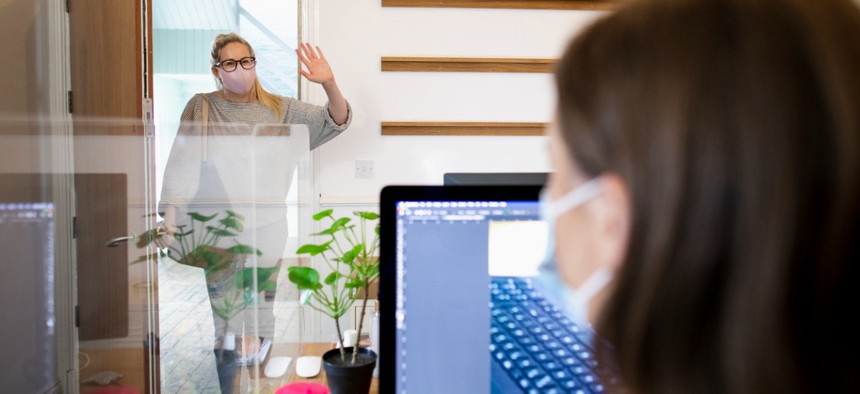A Guide to Delivering Great Experiences for Employees as They Embrace the Future of Work

SolStock/iStock.com
Federal agencies need to invest in technologies that enable employees to work from both the office and remote locations.
Across the nation, private- and public-sector organizations are slowly making their way back to physical workplaces. Federal agencies are following suit as the Biden administration issued a guidance that called on them to submit their own return to workplace plans by July 19.
However, COVID-19 health risks are still imminent, which is why a large majority of the federal workforce won’t be returning to their office spaces as they were. To ensure employees remain safe amid this transitional period, federal agencies will need to adopt a hybrid model, where some staff work onsite while others continue to work remotely.
For this arrangement to work, federal agencies need to invest in technologies that enable employees to work from both the office and remote locations. When employees have flexible, agile modern workflows to do their jobs where, when and how they need to, they’re more productive and more engaged. As federal agencies submitted their return to workplace plans to the Office of Management and Budget earlier this week, the Office of Personnel Management and the General Services Administration, here are a few thoughts on how federal agencies can deliver great experiences to their employees:
Retire In-Office Tasks
Americans are increasingly obtaining the COVID-19 vaccine, but with an uptick in variant cases, federal agencies have a responsibility to keep their workforce safe. Over the past year, federal IT leaders made investments in modern forms of technology. However, the future of work is a hybrid workplace, and therefore, decision-makers must take a thoughtful approach to adopting the right tools that ensure employees are able to work seamlessly in mobile-friendly environments. They can achieve this by first identifying processes that require employees be onsite. These processes are typically outdated and paper-based, such as obtaining manual signatures and processing documents that were received by fax machine or mail.
For example, more than 10,000 IRS employees had to open mail and process tax returns from physical office spaces last April. This directive aimed to reduce the backlog of mail that had been accumulated due to less employees working from IRS campuses due to COVID-19. As federal agencies help employees maintain productive remote work environments or bring them back onsite, they must understand what processes are causing silos and can ultimately be automated. This will ensure employees can work in a mobile-friendly environment and complete tasks with greater efficiency.
Adopt Low-Code Platforms
After identifying the agency systems that do need to be automated, federal employees must adopt the tools needed to help sustain operational readiness, functionality and manage occupancy limits within their agency. One way to achieve this is through the use of low-code or no-code platforms, which are easy to deploy and can enable greater data sharing and reservation capabilities within an organization.
Federal employees can access low-code platforms through multiple devices, which will enable staff to check-in onsite or reserve office space in advance as they split their time between working in-person and in remote environments.
Communicate a Future Vision for Work
Designing the future federal workplace requires a compassionate, collaborative, flexible and cross-functional approach that prioritizes employee safety above all else, and lays out clear expectations, protocols and practices that allow employees to make informed personal choices.
As federal agencies submit their return to the workplace strategies, we’ll likely see varied approaches to this transition. Some of the options include:
- Re-opening the workplace in phases, with the earliest phases enforcing several safety measures to ensure everyone’s health is protected.
- Using rotational methods in which employees work from the office a few days per week.
- Requiring employees to work in shifts to eliminate any overcrowding in the office.
- Allowing employees to become full-time teleworkers, returning to an office setting only when necessary.
Regardless of what approach agencies take, it is imperative that agency leaders collaborate with IT, legal, facilities and HR at every step in this process. In addition, they must communicate their strategy to employees as soon as possible and invest in the tools needed that will maximize their performance during these tough and uncertain times.
Beyond technologies that can establish greater employee experiences, agency leaders should also provide necessary personal protective equipment and hand sanitizer for employees and communicate their return to office health and safety. Establishing and articulating these measures can create a better experience for employees as they move back onsite.
As agency leaders delivered their return to workplace plans for review, they will soon begin executing their strategy for getting employees back into the office. But some federal agencies are more equipped than others to embrace a hybrid workforce model, which means that the next several months will likely serve as a testing ground. To make the transition as smooth as possible, it’s critical that they adopt the right technology and establish safeguards that will help sustain employee productivity and safety. The future of the federal workplace hangs in the balance.
Jonathan Alboum is principal data strategist for the federal government at ServiceNow.
NEXT STORY: Why People End Up Mad When AI Flags Toxic Speech





